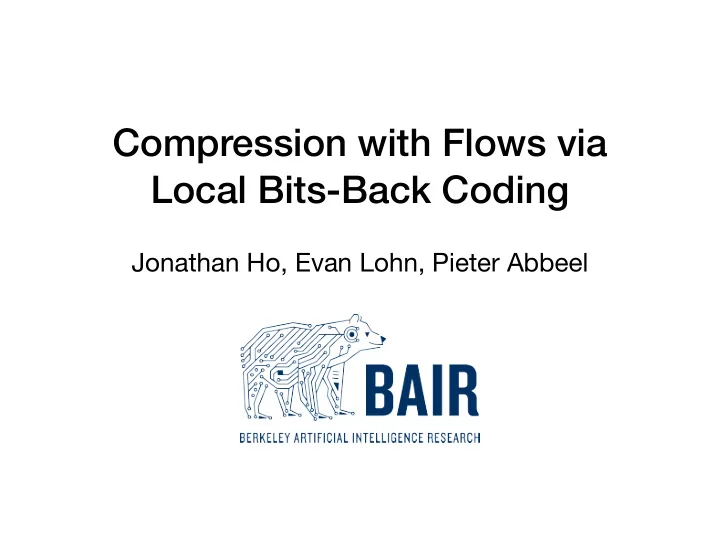

Compression with Flows via Local Bits-Back Coding Jonathan Ho, Evan Lohn, Pieter Abbeel
Background • Lossless compression with likelihood-based generative model p( x ) encode decode 01000101100100110 11101010000101011 • Information theory: a uniquely decodable code exists with lengths ≈ − log p ( x ) • Training (maximum likelihood) optimizes expected codelength • But what about computational e ffi ciency of coding?
Existing compression algorithms • Naive algorithm requires enumerating all data. Needs exponential resources in data dimension • Must harness structure of p( x ) to code e ffi ciently • Autoregressive model: code one dimension at a time • Latent variable models trained with variational inference: bits-back coding
<latexit sha1_base64="3cAYUCWdTOTUmFKx3vHhcEIG6Y=">ACMnicbVDLSgMxFM3UVx1foy7dBEulBS0zIuhGKLqxG6lgH9CpJZNm2tDMgyQj1mG+yY1fIrjQhSJu/QgzbUWtHgczjmX3HuckFEhTfNJy8zMzs0vZBf1peWV1TVjfaMugohjUsMBC3jTQYIw6pOapJKRZsgJ8hxGs7gNPUb14QLGviXchiStod6PnUpRlJHaNie0j2HTe+TeCOLagHRwJGLD5PCuYurBShbev5r9iNih1D9yres5LC92wRwo6RM0vmCPAvsSYkByaodowHuxvgyCO+xAwJ0bLMULZjxCXFjCS6HQkSIjxAPdJS1EceEe14dHIC80rpQjfg6vkSjtSfEzHyhBh6jkqmS4pLxX/81qRdI/aMfXDSBIfjz9yIwZlANP+YJdygiUbKoIwp2pXiPuIyxVy7oqwZo+S+p75cs2RdHOTKJ5M6smALbIMCsMAhKIMzUAU1gMEdeAQv4FW71561N+19HM1ok5lN8Avaxyci26g1</latexit> <latexit sha1_base64="3cAYUCWdTOTUmFKx3vHhcEIG6Y=">ACMnicbVDLSgMxFM3UVx1foy7dBEulBS0zIuhGKLqxG6lgH9CpJZNm2tDMgyQj1mG+yY1fIrjQhSJu/QgzbUWtHgczjmX3HuckFEhTfNJy8zMzs0vZBf1peWV1TVjfaMugohjUsMBC3jTQYIw6pOapJKRZsgJ8hxGs7gNPUb14QLGviXchiStod6PnUpRlJHaNie0j2HTe+TeCOLagHRwJGLD5PCuYurBShbev5r9iNih1D9yres5LC92wRwo6RM0vmCPAvsSYkByaodowHuxvgyCO+xAwJ0bLMULZjxCXFjCS6HQkSIjxAPdJS1EceEe14dHIC80rpQjfg6vkSjtSfEzHyhBh6jkqmS4pLxX/81qRdI/aMfXDSBIfjz9yIwZlANP+YJdygiUbKoIwp2pXiPuIyxVy7oqwZo+S+p75cs2RdHOTKJ5M6smALbIMCsMAhKIMzUAU1gMEdeAQv4FW71561N+19HM1ok5lN8Avaxyci26g1</latexit> <latexit sha1_base64="3cAYUCWdTOTUmFKx3vHhcEIG6Y=">ACMnicbVDLSgMxFM3UVx1foy7dBEulBS0zIuhGKLqxG6lgH9CpJZNm2tDMgyQj1mG+yY1fIrjQhSJu/QgzbUWtHgczjmX3HuckFEhTfNJy8zMzs0vZBf1peWV1TVjfaMugohjUsMBC3jTQYIw6pOapJKRZsgJ8hxGs7gNPUb14QLGviXchiStod6PnUpRlJHaNie0j2HTe+TeCOLagHRwJGLD5PCuYurBShbev5r9iNih1D9yres5LC92wRwo6RM0vmCPAvsSYkByaodowHuxvgyCO+xAwJ0bLMULZjxCXFjCS6HQkSIjxAPdJS1EceEe14dHIC80rpQjfg6vkSjtSfEzHyhBh6jkqmS4pLxX/81qRdI/aMfXDSBIfjz9yIwZlANP+YJdygiUbKoIwp2pXiPuIyxVy7oqwZo+S+p75cs2RdHOTKJ5M6smALbIMCsMAhKIMzUAU1gMEdeAQv4FW71561N+19HM1ok5lN8Avaxyci26g1</latexit> <latexit sha1_base64="3cAYUCWdTOTUmFKx3vHhcEIG6Y=">ACMnicbVDLSgMxFM3UVx1foy7dBEulBS0zIuhGKLqxG6lgH9CpJZNm2tDMgyQj1mG+yY1fIrjQhSJu/QgzbUWtHgczjmX3HuckFEhTfNJy8zMzs0vZBf1peWV1TVjfaMugohjUsMBC3jTQYIw6pOapJKRZsgJ8hxGs7gNPUb14QLGviXchiStod6PnUpRlJHaNie0j2HTe+TeCOLagHRwJGLD5PCuYurBShbev5r9iNih1D9yres5LC92wRwo6RM0vmCPAvsSYkByaodowHuxvgyCO+xAwJ0bLMULZjxCXFjCS6HQkSIjxAPdJS1EceEe14dHIC80rpQjfg6vkSjtSfEzHyhBh6jkqmS4pLxX/81qRdI/aMfXDSBIfjz9yIwZlANP+YJdygiUbKoIwp2pXiPuIyxVy7oqwZo+S+p75cs2RdHOTKJ5M6smALbIMCsMAhKIMzUAU1gMEdeAQv4FW71561N+19HM1ok5lN8Avaxyci26g1</latexit> Flow models z ∼ N (0 , I ) • Flow model: smooth invertible map between noise and data • They are likelihood-based, so coding algorithm must exist • This work: computationally e ffi cient coding for flows
Local approximations of flows • Strategy for coding: locally approximate the flow as a VAE , then apply bits-back coding • Flow model maps data to latent: z = f( x ) • Construct a VAE where f is q( z | x ) and f -1 is p( x | z ) f z x • The VAE bound will closely match the flow’s log likelihood
Local bits-back coding • Our algorithm is bits-back coding on this VAE approximation of the flow • Straightforward implementation needs cubic time in data dimension. No assumptions on flow structure. • Better than exponential, but not fast enough
Specializing local bits-back coding • Making extra assumptions on the flow lets us speed up compression • For RealNVP family: linear time, fully parallelizable compression by exploiting structure of coupling layers and composition
Results • Implemented for Flow++, a RealNVP-type flow model CIFAR10 ImageNet 32x32 ImageNet 64x64 Compression algorithm Theoretical 3.116 3.871 3.701 Local bits-back (ours) 3.118 3.875 3.703 • State of the art fully parallelizable compression on these datasets • Requires “auxiliary bits” for bits-back coding • Codelength can degrade if auxiliary bits are unavailable
Results: speed • Specializing local bits-back to the RealNVP structure speeds up compression by orders of magnitude Algorithm Batch size CIFAR10 ImageNet 32x32 ImageNet 64x64 Black box (Algorithm 1) 1 64 . 37 ± 1 . 05 534 . 74 ± 5 . 91 1349 . 65 ± 2 . 30 Compositional (Section 3.4.3) 1 0 . 77 ± 0 . 01 0 . 93 ± 0 . 02 0 . 69 ± 0 . 02 64 0 . 09 ± 0 . 00 0 . 17 ± 0 . 00 0 . 18 ± 0 . 00 Neural net only, without coding 1 0 . 50 ± 0 . 03 0 . 76 ± 0 . 00 0 . 44 ± 0 . 00 0 . 04 ± 0 . 00 0 . 13 ± 0 . 00 0 . 05 ± 0 . 00 64
Conclusion • Local bits-back coding: compression with flow models • Naive algorithm: exponential time in data dimension • Our algorithm for general flows: polynomial time • Our algorithm for RealNVP family: linear time and parallelizable • For algorithm details and comparisons to other types of models, come to our poster! • Open source: github.com/hojonathanho/localbitsback
Recommend
More recommend